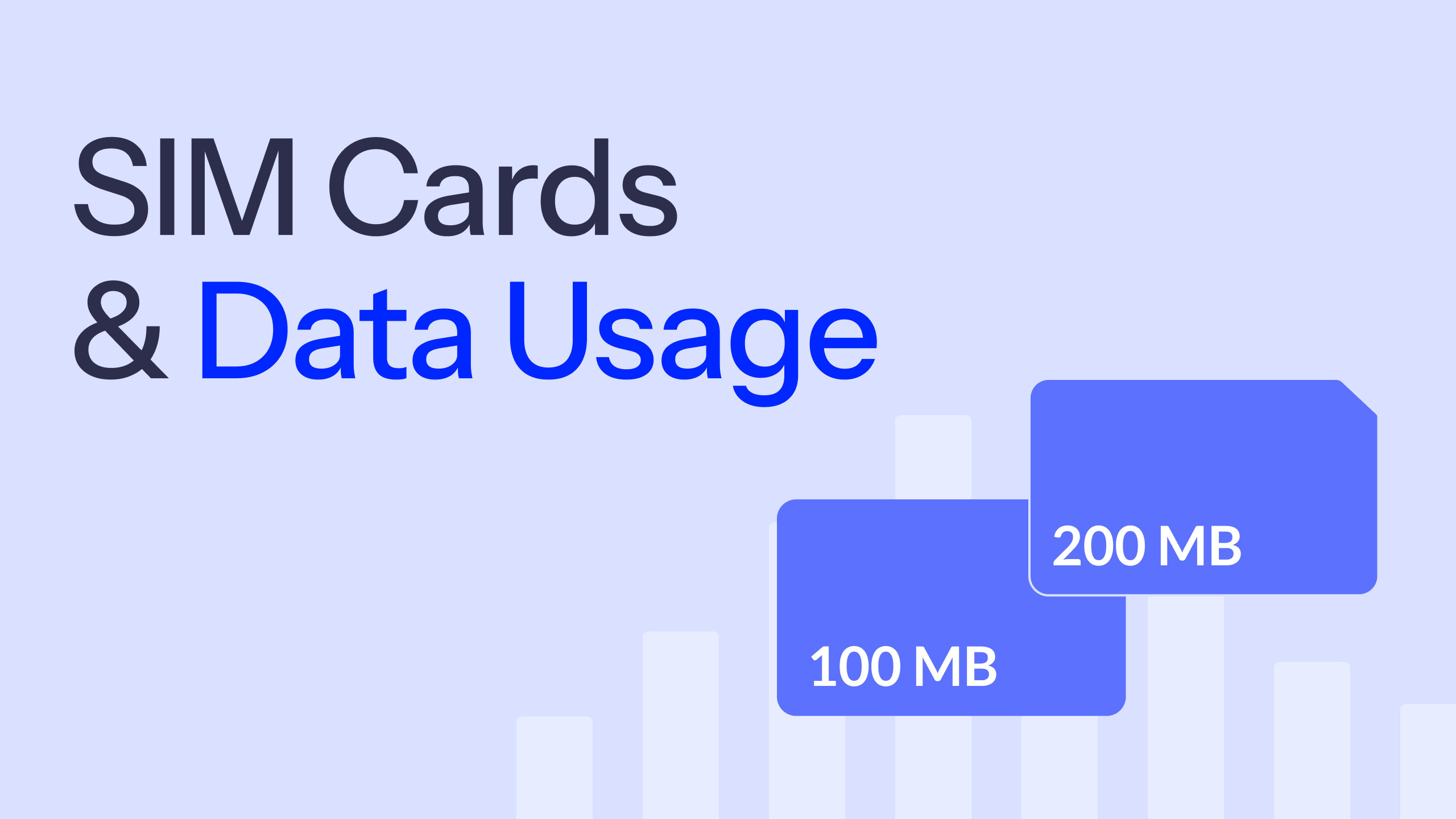Picking a SIM and Mobile Network Operator Solution
Vendor Lock-In
Vendor lock-in occurs when operators don’t control their own SIM cards and contracts. If a hardware or CSMS provider includes the contract as part of their package, migrating away can become extremely difficult. The worst-case scenario is having thousands of SIM cards deployed that all need replacement.
While hardware providers may offer attractive deals that include SIM cards and subscriptions, operators should carefully consider the implications. What happens if the contract expires, the provider stops paying bills, or goes out of business? Will taking over the contract be straightforward?
Similarly, CSMS providers might offer appealing bundle deals combining software and SIM cards. However, operators need to consider their future flexibility—if they want to switch CSMS providers later, can they retain control of their SIM contracts?
Monta recommends that charging station operators maintain direct ownership of their mobile network contracts. This approach maximizes flexibility and prevents vendor lock-in. Though it may not always be the cheapest option initially, it often becomes more cost-effective at scale when operators can negotiate data rates directly rather than through intermediaries.
Pooling
Pooling data consumption for EV charging stations offers significant advantages in terms of flexibility and cost-efficiency. Unlike fixed data plans per station, pooling aggregates the total data allowance across all deployed charging stations. This shared pool allows individual stations that experience higher-than-average data usage (e.g., during firmware updates, remote diagnostics, or heavy utilization) to draw upon the unused capacity of stations with lower consumption. Conversely, stations that see less utilization and data traffic won’t be locked into potentially wasteful individual data allowances. This dynamic allocation ensures that the overall data budget is utilized more effectively, preventing overspending on individual plans and minimizing the risk of data overage charges. By optimizing data consumption across the entire network, pooling provides operators with greater control over their connectivity costs and enhances the overall operational efficiency of their charging infrastructure.
eSIM and eUICC
The term eSIM refers to the physical form factor of the SIM card. Unlike traditional, removable plastic SIMs, an eSIM is a small chip permanently soldered into the device during manufacturing. This embedded nature offers several crucial benefits for IoT deployments:
- Enhanced Durability and Tamper Resistance: By eliminating the physical SIM card tray, eSIMs are significantly more resistant to physical damage from vibrations, extreme temperatures, humidity, and tampering. This robustness is vital for devices deployed in challenging outdoor or public environments, such as EV charging stations.
- Simplified Device Design: The absence of a SIM card slot allows for sleeker and more compact device designs, potentially improving water and dust resistance – critical factors for the longevity of outdoor IoT equipment.
- Remote Management Foundation: The embedded nature of eSIMs lays the groundwork for remote provisioning and management of connectivity profiles, reducing the need for costly and time-consuming on-site interventions.
While eSIM describes the physical embodiment, eUICC refers to the software and security architecture residing on the SIM chip that enables Remote SIM Provisioning (RSP). It is the eUICC that provides the intelligence to store multiple mobile network operator (MNO) profiles securely and allows for switching between them Over-The-Air (OTA) without requiring physical SIM card replacement.
The synergy between eSIM hardware and eUICC software unlocks significant advantages for IoT deployments:
- Remote Operator Switching: The most significant benefit of eUICC is the ability to change mobile network providers remotely. This eliminates the logistical nightmare and cost associated with physically replacing SIM cards in potentially thousands of deployed devices, such as EV charging stations spread across a wide geographical area.
- Mitigating Vendor Lock-in: By enabling remote switching, eUICC empowers charging station operators to avoid being locked into a single connectivity provider bundled with their hardware or software. They gain the flexibility to choose the best network based on coverage, cost, and service level agreements and to switch providers as their needs evolve or more competitive offers become available.
- Improved Network Resilience: In scenarios where a device supports multiple profiles, eUICC can enhance network resilience by allowing for a switch to a backup network provider if the primary network experiences outages or performance issues.
- Simplified Global Deployments: For devices deployed internationally, eUICC facilitates the remote provisioning of local operator profiles, streamlining logistics and reducing the complexities of managing different physical SIM cards for various regions.
- Enhanced Operational Efficiency: Remote SIM management through eUICC significantly reduces the need for on-site technical support for connectivity-related issues, leading to lower operational costs and faster resolution times.
Crucially, while eUICC functionality is commonly associated with eSIM hardware due to the inherent benefits of remote management for embedded, non-removable SIMs, eUICC is not exclusively limited to this form factor. It is possible to implement eUICC on traditional removable plastic SIM cards as well. However, the full potential of eUICC in terms of streamlined remote management is most effectively realized when combined with the embedded nature of eSIMs.
Coverage and Roaming
Non-steering SIM cards and subscriptions improve connectivity by enabling the SIM to dynamically select the strongest or most suitable mobile network available, independent of the provider’s commercial agreements. This results in:
- Better Coverage: Access to multiple networks increases connection availability, especially in areas where a single operator has limited service.
- Enhanced Roaming: Automatic connection to the strongest local network ensures more reliable and higher-quality roaming.
- Optimal Network Selection: The SIM chooses based on signal strength, latency, and technology, not just pre-defined preferences.
- Improved Reliability: Reduced downtime by always connecting to the best available option.
This dynamic selection ensures more consistent and robust connectivity for IoT devices across various locations and during roaming, without being restricted by the SIM provider’s network partnerships.
APN and VPN
An Access Point Name (APN) serves as a connection gateway and contains the necessary configuration details for a mobile device to establish a data link with a mobile network operator’s infrastructure and subsequently access services like the internet or private networks. It essentially tells the device how to communicate with the carrier’s network.
For a charging station operator with a substantial number of stations connected via cellular technology, implementing their own dedicated or private APN offers a range of compelling benefits:
- Elevated Security Posture: A private APN allows the operator to implement more stringent and tailored security measures specifically designed for IoT communication patterns. This isolation of IoT traffic from the public internet reduces potential attack vectors and mitigates the risk of unauthorized access or cyber threats targeting the IoT devices. Furthermore, access control can be tightly managed, ensuring only authenticated and provisioned devices can connect.
- Enhanced Network Management and Control Capabilities: With a dedicated APN, the operator gains greater control over the routing, prioritization, and overall management of data traffic originating from their stations. This enables them to optimize network performance for critical IoT applications, ensure reliable connectivity, and implement specific Quality of Service (QoS) policies. Troubleshooting network issues becomes more efficient as IoT traffic is segregated, providing clearer visibility into potential problems.
- Greater Customization and Flexibility in Network Configuration: A private APN can be tailored to the specific connectivity and operational requirements of diverse IoT deployments. Operators can define custom IP address ranges, routing rules, and access permissions to align with the unique needs of different IoT use cases. This flexibility allows for the optimization of network resources and the implementation of specific functionalities required by the IoT devices.
A VPN (Virtual Private Network) creates a secure, encrypted connection (“tunnel”) over a less secure network like the internet. It encrypts your data by routing your traffic through a VPN server, enhancing privacy and security. A VPN can be implemented together with a custom APN.
Using the right APN/VPN configuration, it can be possible to reach configuration interfaces of charging stations normally only available locally with a wired or Wi-Fi connection on-site. Web-based configuration interfaces or even SSH access can be used to change settings not configurable via OCPP, obtain detailed diagnostics or recover charging stations that have lost OCPP connectivity. Especially for migrating charging stations that do not offer changing OCPP URLs via OCPP configuration, such access may be crucial to avoid expensive on-site visits.
At the moment, Monta OCPP endpoints are only available on the public internet and VPN tunnels into Montas private network behind the public gateway is not possible. However, with secure websockets and OCPP 2.0.1 or Security Profile 2 on OCPP 1.6, the traffic between charging station and Monta will still be end-to-end encrypted and secure. If a VPN is used for charging station connections, the OCPP traffic must exit to the public internet in order to reach Monta public OCPP gateway.
SMS Configuration
Some charging station models support configuration and reset/reboot via SMS messages. This functionality can be beneficial, especially during connectivity problems or migrations. If operators operate stations with such capabilites, making sure the SIM cards are capable of receiving SMS and having a system in place to send them can be of value down the line.
Types of Data Consumption
The following sections will examine the different types of traffic charging stations can have towards Monta and the internet. These different types of traffic combine to become the overall data consumption of the station.
Liveliness Checks
Monta has regular liveliness checks in place to ensure a high quality of service and keep users informed of a charging stations connectivity status. Liveliness checks are based on Websocket ping-pongs and OCPP Heartbeats.
Data consumption for liveliness checks is per charging station and will remain the same no matter how many connectors the station has and how much they are utilized.
At the moment, Monta liveliness checks consume 15 MB of data per month on OCPP 1.6 if the charging station has no downtime. For 2.0.1, it will be 12 MB.
Transaction Related Messages
Transaction messages constitutes authorization, starts, stops, pricing information and most important MeterValue measurements. These messages are sent per connector when the connector is in use. This means data consumption for the whole charging station depends on the number of connectors and how much they are utilized.
The biggest constituent of transaction related messages is MeterValues. These are sampled and sent at regular intervals, depending on configuration. The shorter the interval, the higher the data consumption.
For AC charging stations, Monta sets the default interval to 180 seconds. For DC chargers, the interval is 60 seconds. If charging stations are configured for load balancing, the interval will be set to 30 seconds. Finally, it charging station is enrolled in Monta PowerBank grid services, the interval can be as little as 1 second. If possible, Monta PowerBank will dynamically adjust the sampling interval to save data.
Configuration, Diagnostics and Firmware
All other data consumption that cannot be attributed to liveliness checks and transactions can be grouped as either configuration, diagnostics or firmware related.
Configuration Messages are only exchanged with Monta on first connect, reconnect and change of settings. This means configuration traffic will normally be very limited, but can increase if the charging station is experiencing frequent reconnects or reboots.
Diagnostics can be sent from the charging station in multiple ways. Some charging station brands and models may send additional custom DataTransfers or OCPP specifieced diagnostics messages with extra information or alerts beyond normal OCPP messages. Other brands may operate a parallel connection to a backend system beside Monta, with traffic passing trough the main cellular connection. Finally OCPP offers a mechanism to upload diagnostic files to a server, and these files may have significant size in the range of >10 MB.
Firmware Updates can be triggered via Monta systems or externally and will usually have the charging station download an update file from a specified server. For updates initiated via Monta, the file size will be indicated. File sizes for firmware updates vary significantly in size, with some brands offering files <1 MB. Most files are in the range 1-10 MB in size, but files in the 50-150 MB range regularly occur. This means a single firmware update may blow trough the monthly data cap for a charging station.
Typical Data Consumption per Month
As described above, data consumption depends on number of connectors, their utilization, configuration specifically in respect to meter values and if any configuration, diagnostics or firmware traffic takes. As such, data consumption per month is dependent on charging station brand and model, as well as utilization and use case.
Method
The following numbers are based on real-world data collected by Monta. Data is obtained using two methods: tracking of OCPP traffic per charge point and from the SIM provider. Since the OCPP traffic method only captures the traffic to and from Montas OCPP Gateway, any traffic towards other systems or servers will not be included.
The figure below shows the discrepancy between the two methods of tracking, with positive percentages indicating higher consumption reported on the SIM card than in OCPP. The median difference is 60%.
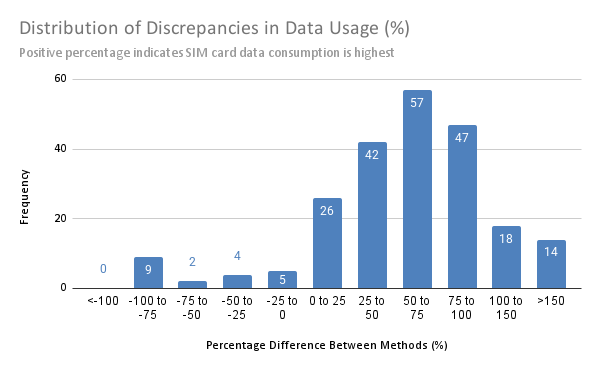
DC Chargers with Two Connectors
General DC Chargers

Typical numbers (OCPP traffic only):
- Per month: 15-75 MB
- Average: 21 MB
- Median: 16 MB
- P95: 39
Alpitronic HyperCharger
The figure belows illustrates the distribution in monthly data consumption for a specific brand of DC charger (Alpitronic HyperCharger). The overal SIM traffic is significantly higher than the OCPP traffic, indicating that the chargers have significant traffic to other systems. It is noteworthy that a single firmware update for Alpitronic HyperCharger is around 100 MB, and Alpitronic operates a separate backend HyperLog which captures significant session data.
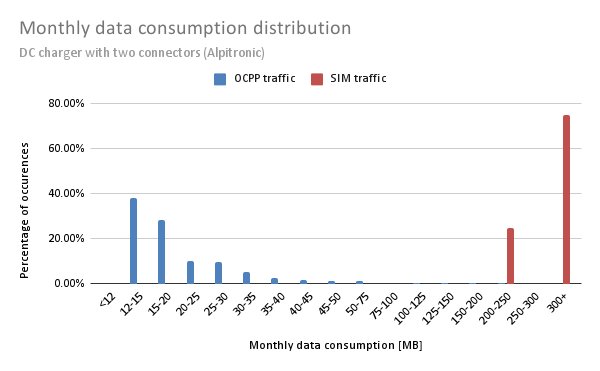
AC Charging Stations with Two Connectors and Monta Load Balancing
Typical numbers (total SIM traffic):
- Per month: 75-240 MB
- Average: 125 MB
- P95: 197 MB
AC Charging Stations with Two Connectors – Mixed Use

Typical numbers (total SIM traffic):
- Per month: 20-200 MB
- Average: 62 MB
- Median: 52 MB
- P95: 156 MB
AC Charging Stations with a Single Connector – Mixed Use
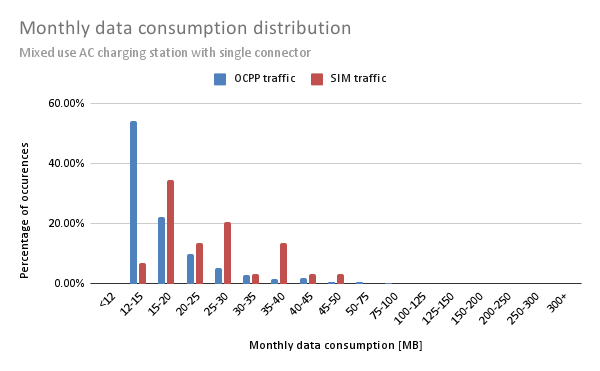
Typical numbers (total SIM traffic):
- Per month: 15-50 MB
- Average: 18.6 MB
- Median: 18.4 MB
- P95: 38.8 MB
AC Charging Stations with a Single Connector – Residential
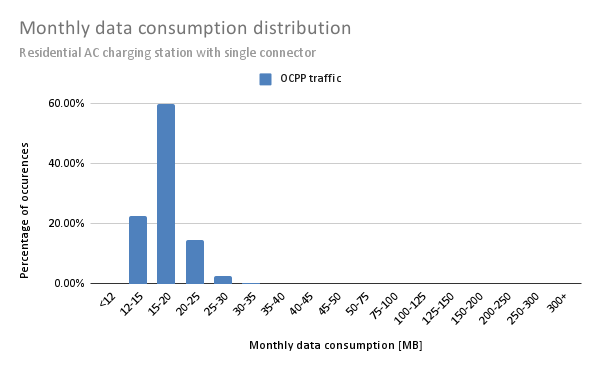
Typical numbers (OCPP traffic only):
- Per month: 12-30 MB
- Average: 17.3 MB
- Median: 16.8
- P95: 23.6 MB
Model Comparison
EVBox Elvi is known to periodically provide custom DataTransfer messages with additional diagnostic information. A comparable model, Zaptec Go, does not do this. This results in overall lower data consumption for Zaptec Go than EVBox Elvi, as seen below.
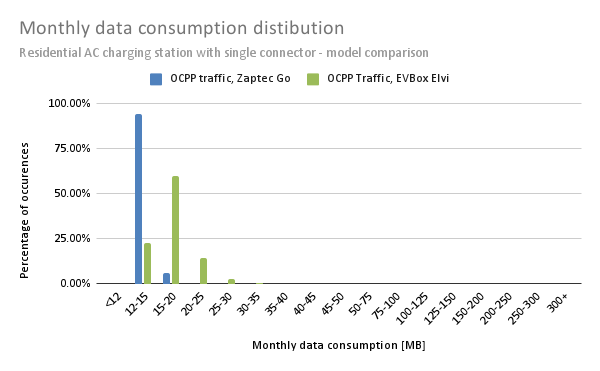
How to Lower Data Consumption
To lower data consumption, the three types of data consumption can again be taken into consideration.
Liveliness Checks
On Monta, liveliness checks are fixed across the platform for all charging station brands and models. For OCPP 1.6, the platform uses regular Heartbeats every 4 minutes and websocket ping-pong every minute. For OCPP 2.0.1, Heartbeats occur every 24 hours with ping-pong every minute, resulting in lower data consumption.
Monta uses these frequent intervals to provide optimal user experience and rapidly detect disconnected stations. While other CSMS providers may use longer intervals, this comes at the expense of user experience.
In addition to server-initiated checks, charging stations may perform their own client-side checks through ping-pongs or server exchanges. Increasing these intervals or disabling them can reduce data consumption.
Transaction Related Messages
The primary component of these messages is MeterValues. Monta configures intervals based on enabled features to deliver real-time updates to users and collect necessary service data.
To reduce data consumption from frequent MeterValues, operators can disable unused energy management and grid services features, including Monta Load Management, SolarCharge, Fuse Protection, and PowerBank.
Operators can also increase the sampling interval by modifying Monta’s default OCPP configurations. However, this will result in less frequent app updates and a reduced user experience.
Configuration, Diagnostics and Firmware
For configuration messages, maintaining stable charging station connections helps prevent unnecessary message exchanges caused by frequent reconnects.
Diagnostic information uploads typically occur only through operator actions, such as GetConfiguration requests. Data consumption can be reduced by limiting the frequency of these requests and narrowing the date ranges. Additionally, operators can reduce or disable model-specific custom DataTransfers, OCPP diagnostics messages, and parallel connections to other management systems.
Firmware updates come with fixed data sizes, and their increased consumption should be viewed as necessary given the security, performance, and feature improvements they provide. For pooled data plans, spreading firmware rollouts across multiple months can help maintain data consumption within limits. While local updates are possible, they typically cost more than the increased data usage unless maintenance is already scheduled on-site.
